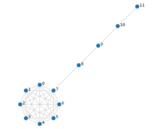Lollipop graph
From HandWiki
| Lollipop graph | |
|---|---|
 A (8,4)-lollipop graph | |
| Vertices | [math]\displaystyle{ m+n }[/math] |
| Edges | [math]\displaystyle{ \tbinom m2 + n }[/math] |
| Girth | [math]\displaystyle{ \left\{\begin{array}{ll}\infty & m \le 2\\ 3 & \text{otherwise}\end{array}\right. }[/math] |
| Properties | connected |
| Notation | [math]\displaystyle{ L_{m,n} }[/math] |
| Table of graphs and parameters | |
In the mathematical discipline of graph theory, the (m,n)-lollipop graph is a special type of graph consisting of a complete graph (clique) on m vertices and a path graph on n vertices, connected with a bridge. [1]
The special case of the (2n/3,n/3)-lollipop graphs are known as graphs which achieve the maximum possible hitting time,[2] cover time[3] and commute time.[4]
See also
References
- ↑ Weisstein, Eric. "Lollipop Graph". Wolfram MathWorld. http://mathworld.wolfram.com/LollipopGraph.html. Retrieved 19 August 2015.
- ↑ Brightwell, Graham; Winkler, Peter (September 1990). "Maximum hitting time for random walks on graphs". Random Structures & Algorithms 1 (3): 263–276. doi:10.1002/rsa.3240010303.
- ↑ Feige, Uriel (August 1995). "A tight upper bound on the cover time for random walks on graphs". Random Structures & Algorithms 6: 51–54. doi:10.1002/rsa.3240060106.
- ↑ Jonasson, Johan (March 2000). "Lollipop graphs are extremal for commute times". Random Structures and Algorithms 16 (2): 131–142. doi:10.1002/(SICI)1098-2418(200003)16:2<131::AID-RSA1>3.0.CO;2-3.
 |

